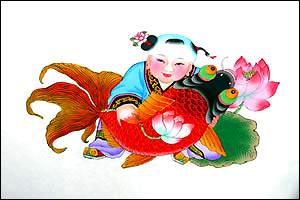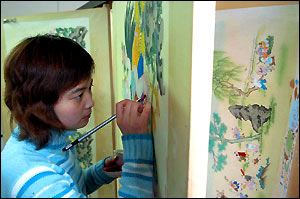| Tools: Save | Print | E-mail | Most Read |
| Will China Lose Its Nianhua? |
| Adjust font size: |
Through the years, the three Lunar New Year decoration must-haves have been the woodcut picture or nianhua, the firecracker and the paper cutting. However, since the 1980s, nianhua that used to sell like hot cakes during the festive season has been gradually losing its place of importance. The State Post Bureau on January 22 issued special stamps featuring "Wuqiang Lunar New Year Woodcut Pictures," rekindling people's fervor in this traditional folk art. But this might prove to be an effort that is too little, too late. Yangliuqing in Tianjin, Taohuawu in Suzhou, Yangjiabu in Weifang, and Wuqiang in Hebei are where four of the country's most popular types of nianhua originated, each with its own unique characteristics. Yangliuqing pictures, made in an imperial-court decorative style, are a spectrum of gorgeous colors. The fresh, meticulous Taohuawu pictures present the natural scenery of south China. Yangjiabu and Wuqiang pictures permeate with a pronounced local flavor.
A model of residential housing on display at the Wuqiang Museum of Lunar New Year Pictures shows that in past customs to celebrate the Spring Festival included pasting nianhua everywhere around the house, a different type for the different rooms of the house: the portrait of the Door God posted on the front door, the God of Wealth in the central room, and the God of the Hearth in the kitchen. Even the stable had its peculiar decoration. However, Yangliuqing and Taohuawu ceased batch-producing nianhua since 1985, and nianhua at Spring Festival is rarely seen nowadays. These days, it is viewed more as a collector's item, according to Guo Shurong, vice curator of Wuqiang's nianhua museum. While the nianhua might have faded out of the memories of the Chinese, many out-of-print woodcut pictures have been showcased in the British Museum in London and some galleries in the United States, and become part of their more valuable collections. And although the nianhua might not be highly regarded by common people, it seems to be doing well on the antiques market. In 2000, a set of 16 woodcut watercolors and a single woodcut picture were auctioned off in Beijing for 8,800 yuan (US$1,100) and 9,600 yuan (US$1,200) respectively. "Nowadays, people have lots of recreational activities during the Spring Festival. It's not surprising that many don't feel the need to paste nianhua around the house," Feng Jicai, chairman of Chinese Folk Literature and Art Association, was quoted by Xinhua News Agency as saying on January 23. In many places, nianhua has actually become a "brand name" that helps promote the development of local tourism. In 1998, Weifang invested 20 million yuan (US$2.5 million) in a folk customs and tourism development zone in Yangjiabu, which receives 500,000 Chinese and foreign visitors annually. With its well-reputed nianhua, Yangliuqing in Tianjin also draws countless tourists every May Day and National Day holidays. But the commercialism worries older artisans who believe that the cultural message contained in nianhua could soon be lost completely.
Since 2002, several nianhua museums have opened in Wuqiang, Mianzhu in Sichuan, and Zhuxianzhen in Henan, in the hope of saving the endangered folk art. The Tianjin-based Nankai University even offered a Yangliuqing nianhua workshop to train young artisans. Luo Shuwei, a researcher with the Tianjin Academy of Social Sciences, has proposed conducting a thorough investigation into the present situation of nianhua, and establishing local nianhua associations at an early date, where artisans can come together to discuss their art. Further, because most artisans come from peasant families and have little formal schooling, Luo has suggested that local governments adopt a preferential policy to help promote the sale of their products. Luo added, "Traditional folk art including nianhua should be treated as an academic subject like any other that is taught in humanities courses. This would encourage accomplished folk artists to take part in teaching and research in qualified colleges and universities." (China.org.cn by Shao Da, February 2, 2006) |
| Tools: Save | Print | E-mail | Most Read |
 |
| Related Stories |
| Product Directory China Search |
Country Search Hot Buys |

